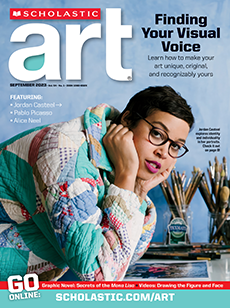Phil Skinner/Atlanta Journal-Constitution via AP Images. All other images courtesy of Maya Penn.
Maya Penn
Scholastic Art: What is your job?
Maya Penn: I am the founder and CEO of a sustainable fashion company that I started when I was 8 years old. It’s called Maya’s Ideas.
SA: What drew you to sustainable fashion design?
MP: I’ve always had a passion for nature and eco-friendliness. So when I had an idea for a fashion line, I started doing research on the fashion industry and its environmental impacts. I learned that the fashion industry produces 1.2 billion tons of CO2 per year—that’s more carbon emissions than all international flights and maritime shipping combined! This is a result of “fast fashion,” clothing that is overproduced and cheaply made with synthetic materials. I wanted to create a sustainable alternative to fast fashion while using art and design to raise awareness about the importance of sustainability in the fashion industry.
